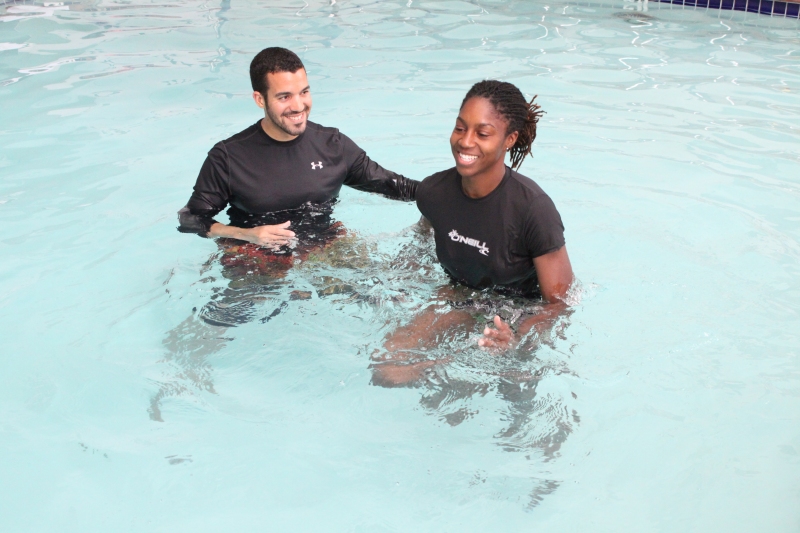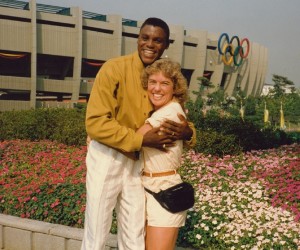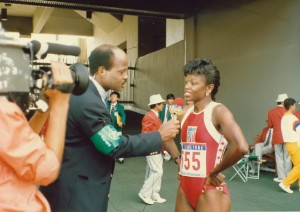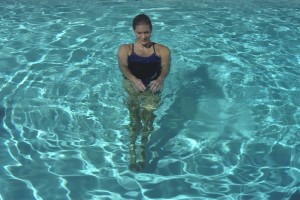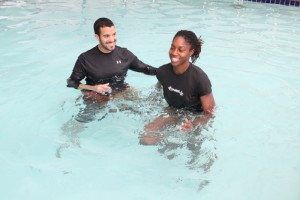When you can’t run on land, you CAN run in the water. And you, like hundreds of skeptical world-class athletes before you, will change your mind about the pool being for sissies once you feel the power of water. Here are a few of the top runners who have benefited from my program:
Mary Decker Slaney was America’s premier middle-distance runner in the 1980s. Often injured, she took to the pool for deep-water interval training for a month. Her first day back on the track, she set an American record for 2,000 metres.
One day in 2002, our pool was filled with former and future Olympic track athletes. Carl Lewis, owner of multiple gold medals for sprints, jumped in the pool with us to feel for himself what he’d been hearing about for years. He knew he’d gotten his day’s workout without going to the track.
Marathoner Joan Benoit had arthroscopic knee surgery only a few months before the Los Angeles Olympic Games. She came to our pool and did deep-water interval training with Jacqueline Hansen, the former world record-holder in the event. Joan stayed in world-class shape and won the first-ever women’s Olympic marathon gold medal.
Valerie Brisco won three gold medals at the Los Angeles Olympic Games (200M, 400M, 4 x 400M relay). She won a bronze medal in Seoul in the 400 and silver in the 4 x 400M relay. Whenever she was slightly injured, coach Bobby Kersee sent her to me to the pool for a few weeks. She returned to the track without losing a step.
Doing pool workouts develops cardiovascular fitness, increased flexibility, improved balance and coordination, and best of all, a sense of well-being. It doesn’t matter if you’re in the middle of winter in England, the middle of summer in Australia, or somewhere in-between in America. You have the same weather protection when going to an indoor pool as going to the gym. So forget the season and jump in.
But where do you find water? Some of you may have pools in your backyard or in your building. But most of you will have to search for a pool for your workout. Nearly every community these days has a public pool that can be used for a small fee. Find one near your home or work where the hours fit your schedule so you can easily go there when you sense you need to rest sore or tired joints or muscles.
A Gear Checklist
- You’ll need a bathing suit. There are many new styles of suits these days, down to the elbows and knees if that makes you more comfortable going to a public pool.
- You’ve already located your pool of choice, and depending upon the water temperature of that pool and how warm you like to be, you might opt for a fleece rash guard or a neoprene zip-up shirt to keep you warm. (www.completept.com/pages/equip-w.html).
- If you have tender feet, you can wear pool shoes. There are many inexpensive brands and generics available.
- You will also need a flotation belt to keep you upright in deep water. Don’t try to do your deep-water running without such a belt – you’ll not be able to maintain good running form, because you’ll be making extraneous stay-afloat movements. If you’re an elite runner with little body fat, you’re probably a “sinker” and you will need the new CompletePT belt, formerly the Hydro-Tone most buoyant of all belts.
Ready to go? Strap on a flotation belt (www.completept.com/pages/equip-w.html) and move to the deep end of the pool. When your feet aren’t touching the bottom, you’re deep enough. You’ll do the following three deep-water techniques to increase cardiovascular fitness, muscle strength, flexibility, and coordination. Alternating between these three movements lets you add variety to what would otherwise be incredibly boring if all you did was run.
DEEP-WATER RUNNING
In deep water, we only do the back half of the running motion; that is, there’s no forward reach with the foreleg and foot. In fact, if you can see your feet you’re not running correctly. Lift one knee while you drive the other foot down and back.
Find a focal point straight ahead and hold your eyes on it as you begin running in an upright position. Use the same motion of good running form on land. If you don’t think you have good running form, this would be a good time to work on it with another runner who can view your arm and leg action. Keep your head and chest erect and your shoulders relaxed and down. If you aren’t tethered, the tendency will be to lean forward and try to reach the other side of the pool. The point isn’t to travel anywhere but to focus on turnover rate and simulating your usual effort level during a run. So keep your chest lifted as you run or get a tether to help with good form.
WATER WALKING
Start by establishing an “opposition position,” right arm and left leg forward at the same time. Begin walking, swinging your straight arms and legs forward and backward. Some people compare this to a cross-country skiing motion. Visually check your elbow and knees. Many people think their arms and legs are straight when they are not. These long levers of straight arms and legs create great resistance for a workout and force you to improve your core strength and body alignment.
FLIES
Flies are similar to jumping jacks. Start with your hands together in front of you and your feet together below. Pull your hands and feet open wide, then bring them back together again. Continue opening and closing your arms and legs. Keep your hands facing down, sliding just beneath the surface of the water. It’s easiest to learn this if you lean slightly backward at first.
Do 2-3 minutes of Running, then 2 minutes of Walking, then 1 minute of Flies. You should be warmed up by then. Spend most of your time running – you’re a runner and that’s what you came here to do. But whenever you feel yourself losing interest, switch to Walking and Flies to regain your focus then go back to running at a faster pace. That will keep you on track!
Be Sure to Follow These Basic Principles
- Start running slowly until you’re warmed up. Depending on your pool’s water temperature, that may take 1-5 minutes. Gradually increase your speed as you warm up.
- Ask a coach to help you with good form. In water, you’ll feel yourself pulled off balance if your arms swing to the side, so here’s a chance for you to improve your running form. Good form lets you slice through the water without sideways movements. Someone giving you cues as you run will help you attain good form.
- Visualize yourself running over your favorite course. Pick up speed as you mentally turn that corner and start down the slight hill. Mentally put your favorite running partner beside you.
- Consider adding speed-play to your pool workout. Vary your speed throughout the session to increase your heart rate. Run fast, recover, and then push yourself to run fast again. Try 2 minutes at a moderate pace, 1 minute higher intensity then alternate between 2 minutes moderate and 1 minute fast until you feel your typical level of fatigue.
- Your running workouts will be based on time rather than distance. For example, if you were planning a moderate five-mile run at 8-minute pace, that equates to forty minutes of running in the pool. Toss in some Walking and Flies occasionally for variety. After your warm-up (see #2), you can begin interval training if that’s what’s right for you. If you wanted to do some repeat 1/2 mile runs, simulate the effort level and cadence of doing that on land. If you wanted to do 5 x 200 Meters, sprint in chest-deep water for a nice round 30 seconds. Jog on place to recover, then repeat until you’ve done five.
- Stretch for your warm down. Put your foot on the side of the pool and hold the deck to stretch one hamstring, then the other. Move to shallow water, hold the side of the pool and grasp your ankle to stretch your quads. Do other stretches of your choosing that feel good to you at the end of your workout.
- Make it FUN! Remember how much fun it was to play in a pool when you were a kid? It can still be lots of fun – and enjoy the great satisfaction you feel when you get out of the water.
If you want some visual cues to learn these pool techniques you’ll find laminated pool exercise sheets, books and DVDs at completept.com/pages/equip-w.html.
Lynda Huey pioneered the use of water rehabilitation in athletics with the many members of the USA Olympic track and field team. She has water-trained some of the world’s best athletes in basketball, ice hockey, tennis, volleyball and football, as well as the Hollywood elite. Lynda has taught her water therapy techniques to thousands of coaches, therapists, and doctors, and has certified hundreds in her methods. Lynda’s books and practices are considered the foundation of aquatic physical therapy world-wide. She owns and operates CompletePT, two pool and land physical therapy clinics in Los Angeles that treat over 630 patients each week. For more information visit www.completept.com

